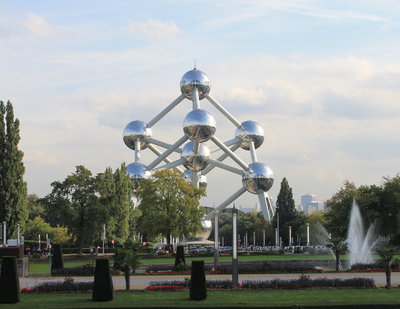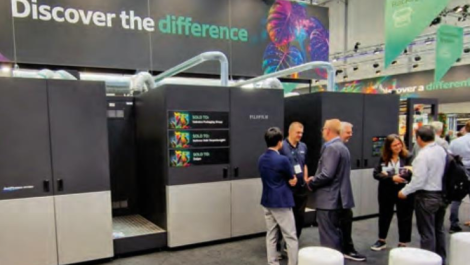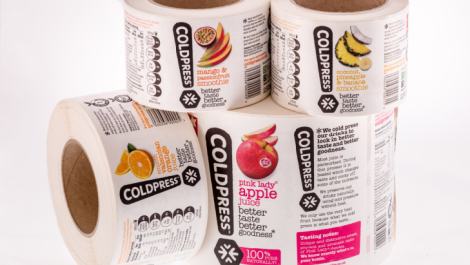Boasting record breaking visitor numbers, Labelexpo Europe proved that the industry is no longer in the grip of the recession. For digital, the show was a resounding success with numerous new presses launches, particularly with inkjet technology. By Neel Madsen and Michal Lodej.
With the report that 31,795 visitors came to the Brussels Expo at the end of September, Labelexpo Europe brought us the positive news that we needed, namely that people are buying again. Seven halls were filled by some 600 exhibitors, which launched over 150 new products to the market and welcomed visitors from 158 countries.
Inkjet was a major topic of conversation (covered separately), in particular, suppliers were keen to present the most opaque single pass white, however, toner technologies also dominated with HP Indigo taking over a whole hall to display its wide range of solutions under the heading ‘Print Your Future’, and Xeikon launching its new ICE toner and taking part in the Package Printing Workshop.
AB Graphic launched new label converting lines and an array of options designed to increase productivity and simplify operation on both its new and existing product ranges. The show also saw the debut of the company’s DigiLase laser die-cutting system with digital die shop software enabling users to import, create or edit die patterns. Together withEdale,it launched the Digicon 3000, a 762 mm wide finishing line compatible with the new HP Indigo 20000 digital press.
Avery Dennison has recently expanded its FSC-certified portfolio of paper label materials available in Europe. At the show, the focus was on sustainability with the introduction of a number of products, including the CleanFlake (bottle-to-bottle) film portfolio, which consists of an adhesive and film combination that separates cleanly and efficiently from the PET flakes produced during the recycling process.
EFI introduced the Jetrion 4950LX press (see inkjet feature for more details) and new finishing modules for the 4900 press line. It also demonstrated its web to print tools for packaging companies, and packaging ERP/MIS products, including a new option for Radius, the Printflow dynamic scheduling for optimisation of the printing operation.
Esko‘s Store Visualizer was brought to life in 3D in the HP hall where visitors got the full immersive experience by donning 3D glasses and watching a demo on a large video wall. HP, Sharp Iris and Esko had set up a large Barco 3D OLS-721 stereoscopic video wall to demonstrate how 3D imaging can help packaging professionals see products on shelf in a shop, without creating physical mock ups.
Exxonmobil introduced three new Label-Lyte oriented polypropylene (OPP) films for labelling applications along with five other films in the range that were first shown to the market at the American Labelexpo in 2012.
Gallus presented its Print Concept, in effect a small label printing shop, which drew in visitors to demonstrate how digital and conventional manufacturing processes combine to save time and money in label production.
Christof Naier, vice president sales and marketing, said, ‘In total we held 61 live demonstrations with over 30% more visitors compared to 2011. Particularly the Print Shop concept including the highly flexible near-line solution comprising the Heidelberg Linoprint L digital printing system and further processing on the Gallus ECS C generated a lot of attention.’
HP introduced a new silver ink for the HP Indigo WS6600 digital press, giving label printers new capabilities, along with the news that the company has sold more than 500 Indigo WS6000 series digital presses.
Alon Bar-Shany, vice president and general manager, Indigo digital press division, said, ‘Business for the 6000 series is growing and this is due to the increased print volumes of our customers. Our customer, Rako Etiketten has bought many presses, including the 500th.’
Demonstrated for the first time at the show were new end-to-end solutions for the Indigo 20000 and 30000 aimed at accelerating the transformation of the folding cartons and flexible packaging markets. As well as machinery, there was a veritable abundance of samples on shelves, including numerous personalised Coca-Cola bottles demonstrating the campaign’s huge success.
Highcon and Scodix were working together with HP to show a complete digital packaging production workflow. Sample cartons were shown which had been printed on the HP Indigo 30000 and converted on the Highcon Euclid digital cutter and creaser with Scodix embellishments added.
Hybrid Software launched Cloudflow, which promises to ‘introduce a totally new ‘workspace’ concept to the web-enabled production environment.’ A web-based portal solution, it has been built using HTML5 technology for compatibility with major browsers, tablets and smartphones, and is of a modular design.
iSys Label showed its two toner-based label printers, the Apex 1290 and the Edge 850. Mark Hopkins, president, said, ‘Our presses offer high quality and allow printers to take the small jobs off the big press. Our strength is in print on-demand whether the press is working on its own or alongside a larger press.’
He also presented a case study, entitled ‘signature printing’, in which a high volume winery needed to print labels for its different types of wine and used conventional technology to print the base label and then overprint as needed on the Apex 1290.
Kama was in the HP hall with the DC 76 finishing line which features 10 different applications includinghot foil stamping, hologram application, and die-cutting, creasing, perforating, kiss-cutting and cold embossing. Featuring AutoRegister, which aligns each sheet to within +/- 0.1 mm, the machine can convert sheets of up to 760 x 600 mm in size and process up to 5,500 sheets per hour.
Kodak announced partnership agreements with Bobst and Uteco Converting. While the exact nature of the agreement with Bobst is to be confirmed, the deal with Uteco sees Kodak’s Stream inkjet technology combined with Uteco’s wide web press experience to unite flexo and digital on one press.
Lintec Europe is the distributor of the new Iwatsu EM-250W five colour LabelMeister UV inkjet press, which was introduced at the show. Printing at up to 50 m/min with piezo drop-on-demand printheads, it is a compact machine taking up only 10.2 square metres of space.
Martin Automatic enjoyed a highly successful show, according to marketing manager, Craig Thomson, who commented, ‘There is no doubt this is the leading global show for the narrow web industry, and it was a rewarding experience to see the industry in such a positive mood – this can only be good for everyone moving forward.’
Mitsubishi HiTec Paper said visitors showed great interest in the re-launch of Supercote, the premium cast-coated label paper, which is available in two grammages and in a wet-strength version.
Newfoil Machines introduced afour colour inkjet printer with a 1600 x 1600 dpi resolution and speeds up to 18 m/min. This was running linked to a Newfoil 2500 servo hot stamping and die-cutting machine for inline single pass label production.
Phoseon‘s UV LED technology could be seen on inkjet and flexo OEM stands throughout the show. Stacy Hoge, marketing and communications specialist, said, ‘UV LED curing technology was a hot topic this year. Our high amount of traffic from OEMs, ink suppliers and end users interested in this curing technology was really impressive. UV LED for digital inkjet has been gaining worldwide adoption for several years and, there were more than 15 stands running UV LED for digital inkjet at the show.’
Along with its label combos, the CX1000e/FX1000e and the CX1200e/FX1200e, Primera Technology Europe presented the new AP550e Label Applicator and LP130e Laser Marking System. It also ran a label competition to show off what its customers can produce. The winner was a wine label produced by Sanbesan SL in Spain, which won a complete toner kit for the CX1200e.
RTI Digital, formerly OWN-X, introduced the Vortex 851R label printer. The roll-fed machine offers full colour drop-on-demand thermal inkjet printing through its 70,400 nozzles on the memjet printhead. It can print on various inkjet coated materials at speeds of up to 30 cm per second with a 1,600 dpi native resolution.
RotoMetrics showedits Accu-Series of flexible dies, which has been optimised to just four products that cover the entire range of applications, from abrasive materials to ultra thin liners. The AccuSmart die is the economical choice for short to medium runs ideal for standard liners. AccuPrime is a popular choice aimed at thinner liners down to around 30 microns, while AccuStar UltraFilm accommodates very tight plate tolerances for very thin liners down to 12 microns. The final product is the AccuStar Life developed for very long runs and abrasive materials and coatings.
SunJet, the global inkjet division of Sun Chemical, presented its portfolio of single pass inkjet inks and unveiled its new low migration ink technology which complies with the Swiss Ordinance and Nestlé standards. It also provided information on the EtiJet products, including ink technology designed for Konica Minolta, Kyocera and Xaar printheads.
UPM Raflatac introduced the ‘Label Life’ concept together with a new, tool aimed at helping label printers and end users understand the life cycle impacts of different label stock products and get credible information on the environmental performance of their labels. The company also introduced new films for the personal care and wine & spirits markets.
Vetaphone introduced a new operator friendly solution for its VE1A corona treater station, which involves mounting an interface on the treater itself in the form of a touchscreen device. This gives the operator easy access to control the treater and eliminates the need for mounting an external control panel.
Labelexpo saw the culmination of Xeikon‘s See-the-Proof campaign, which had run in the weeks leading up to the show. The object of the exercise was to promote the new ICE toner, which cures at lower temperatures thereby enabling the use of a broader range of applications, including PE. Some 150 jobs were uploaded to the site from around the world, including Uzbekistan, and printed on five different substrates that the printers could then pick up at the show.
After the takeover of Xeikon by Bencis Capital Partners and Gimv-XL, Wim Maes had returned as CEO of the company just a few days before the show, and at the press conference, outlined its future plans which include delisting and making Xeikon a private company. However, the strategy remains the same, namely to grow and invest in order to be in the top three players.
————————————————————————
Digital vs flexo
Labelexpo presented two technologies at the Package Printing Workshop, each one fighting for its place in the market and showing spectators what they could achieve. Flexo and digital went head to head.
Nick Coombes, consultant editor, presented the workshop. On one side stood the Xeikon 3500 digital press, which was in the capable hands of Filip Weymans, Xeikon’s director of segment marketing and business development. On the other stood the Gidue Combat M3 Digital Flexo press, under the control of Gidue owner, Federico D’Annunzio.
It was the flexo press, which was given the stage first. Mr D’Annunzio guided onlookers through the various new features of the press, which he said makes it different from any flexo press launched before.
High definition cameras control the printing pressure and the system inspects both sides of the substrate, just as an operator would do. It is then die-cut, a process also controlled by digital cameras.
Mr D’Annunzio, explained, ‘When printing on flexible substrates it is critical to be able to control the temperature of the substrate to within one degree. The tension must also be controlled, this must be smooth and so it is better to have servo driven rollers.’
Then it was time for digital to have its say, with Mr Weymans presenting the digital press to the crowd. The press printed and finished chocolate boxes, all with the option of personalisation and all inline. A number of business card were collected from the audience. Taking the names from the cards and typing them into the X-800 digital front end, the boxes were then personalised.
Mr Weymans said, ‘For short run and high quality printing, the Xeikon 3500 really is a practical solution and is becoming more and more popular.’
The Package Printing Workshop showed that these two technologies, whilst very different, both have strong advantages for users, and neither one is budging from its share in the labels and packaging market.
————————————————————————






